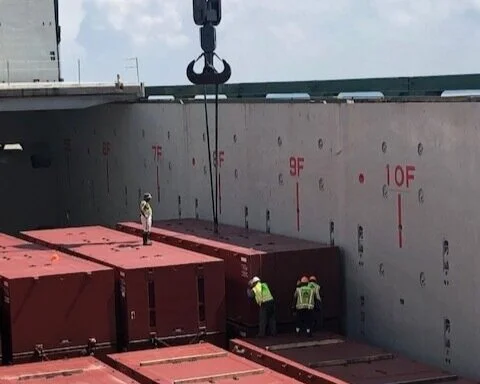Our Services in Action
Our Client’s
Bridges and Barges
When one of our long-time clients, the bridge manufacturer Acrow Corporation of America, came to us for support shipping bridges to a U.S. military base in Sagamihara, Japan, we were eager to help them work through the project’s priorities, pressures, and challenges. We partnered with the Acrow team to develop a plan that best suited their unique needs: shipping the bridge section in containers via a conventional steamship line while sending the breakbulk separately on a chartered vessel that suited the project’s time constraints.
The container-shipping component of the project was fairly straightforward and gave us a chance to build trusted partnerships in Japan that would end up serving our client later. We developed a live-load schedule for a live-load 70 x 40-foot HC shipper-owned containers between the plant in Lafayette, New Jersey, and the load port in Newark, New Jersey. Given the complexity of the shipment, we provided door-to-door service in partnership with the shipping line APL on U.S. Flag vessels, a requirement of any U.S. military project like this one. Because of the high container volume, we were on-site at the dock to ensure they all made it onto the vessel, and once the ship set sail, we did a full BOL reconciliation, tracked the vessel’s progress, and worked with the importer to prepare required documentation and U.S. military exemptions in order to clear cargo as quickly as possible at the destination. Before making our booking, we requested extra free time at the destination port because of the number of containers. Securing this gave us necessary leeway while we coordinated deliveries of the containers to the base with the carrier and the trucking company. During this leg of the project, Jared Weiss, Target Shipping’s president, traveled to Tokyo to get a better handle on the specific challenges of freight receiving in Japan and to develop relationships with agents and terminal representatives to help streamline the process.
The second part of this project, shipping of the barges, presented challenges, including one particularly big one: The original U.S. flag vessel that the cargo was booked to ship on was unexpectedly dry-docked, and the next vessel wasn’t available for a month. We needed to come up with a new, cost-effective solution that worked with the Acrow team’s deadline to deliver without incurring penalties. We dug deep into our networks and resources and were able to source a U.S. Flag vessel headed toward Asia and available for a part charter. As we waited for the confirmation of the vessel’s other booking, which would lock in the voyage, we continued delivering cargo—a combination of eighty 40- and 20-foot barges—from Berne, Indiana, to the loading terminal at the port in Wilmington, Delaware. A calculated risk paid off. We wanted to ensure that the cargo would be ready as soon as confirmation came through and wouldn’t cause any disruptions or delays. We coordinated the deliveries to and from the ports on both ends, leaning on our own expertise, trusted partners, and trucking and terminal relationships. On the day the vessel set sail in mid-2019, everything went smoothly, and while the freight was on the water en route to the port in Yokohama, we were coordinating with the destination terminal and the vessel owner’s agent to prepare documentation for cargo clearance, renew our previous permits, perform road surveys, and determine the best delivery routes and times. In this case, we trucked the cargo overnight to be unloaded at its final destination first thing in the morning. The project went off without a hitch—a true testament to our team’s diligence throughout the process, asking the right questions, looking for alternative solutions, and fostering relationships with people who have become trusted partners.


